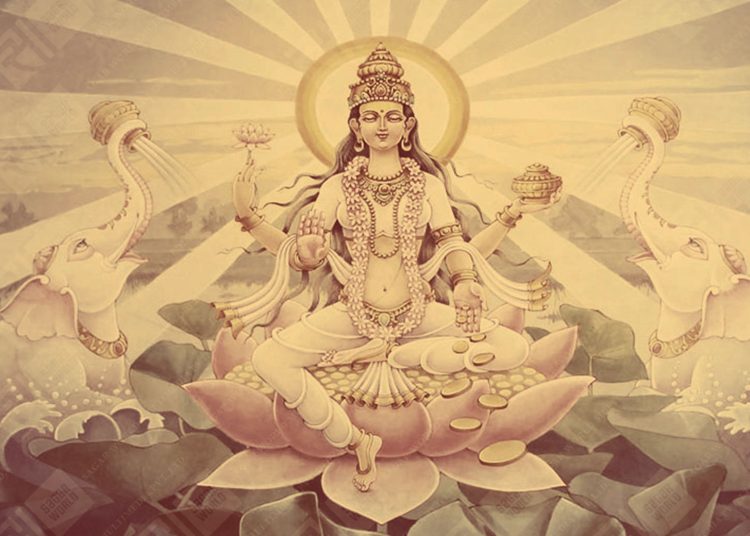(Other names: Mahalaxmi, Padma, kamala, dhanlakshmi)
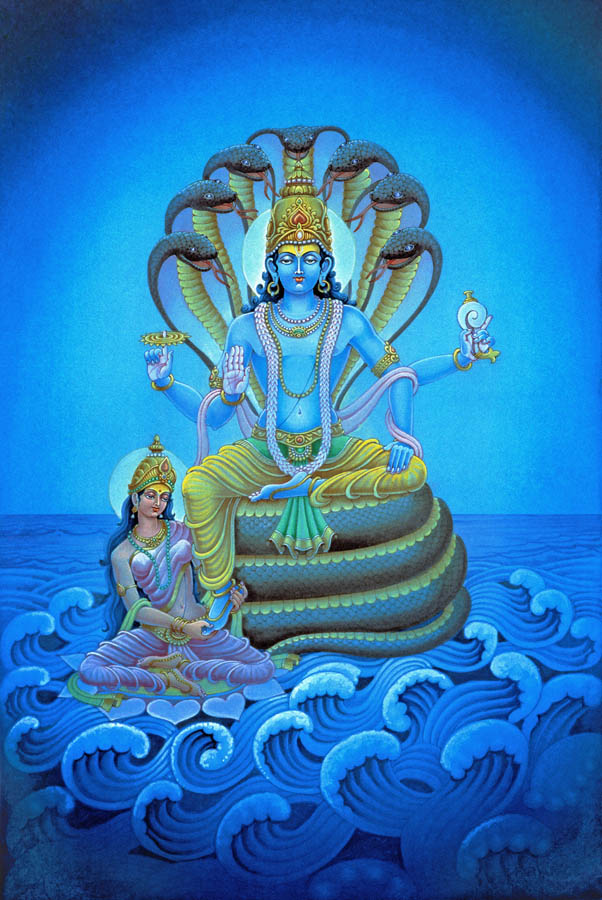
Laxmi is a part of the Hindu Trinity of goddesses which comprises of Saraswati (daughter of Brahma and goddess of arts and knowledge), Laxmi (wife of Lord Vishnu and goddess of wealth and prosperity) and Parvati (wife of Lord Shiva and goddess of spiritual wealth).
Laxmi is the daughter of Bhrigu and Khyaati and resided in Swarg but due to the curse of Durvasa, she left Swarg and made Ksheersagar her home.
When the deities and demons churned the ocean, fourteen jewels were found and Laxmi was one of these jewels. Vishnu accepted her as his wife.
Golden coloured and with four hands, Laxmi resides in the Ksheersagar with her husband Vishnu.
Laxmi is believed to be the Goddess of wealth and prosperity, both material and spiritual. The word ”Laxmi” is derived from the Sanskrit word Laksme, meaning “goal.” Laxmi, therefore, represents the goal of life, which includes worldly as well as spiritual prosperity.
In Her images and pictures, Laxmi is depicted in a female form with four arms and four hands. She wears red clothes with a golden lining and is standing on a lotus. She has golden coins and lotuses in her hands.
Two elephants are shown next to the Goddess. This symbolism conveys the following spiritual theme -The four arms represent the four directions in space and thus symbolise omnipresence and omnipotence of the Goddess.
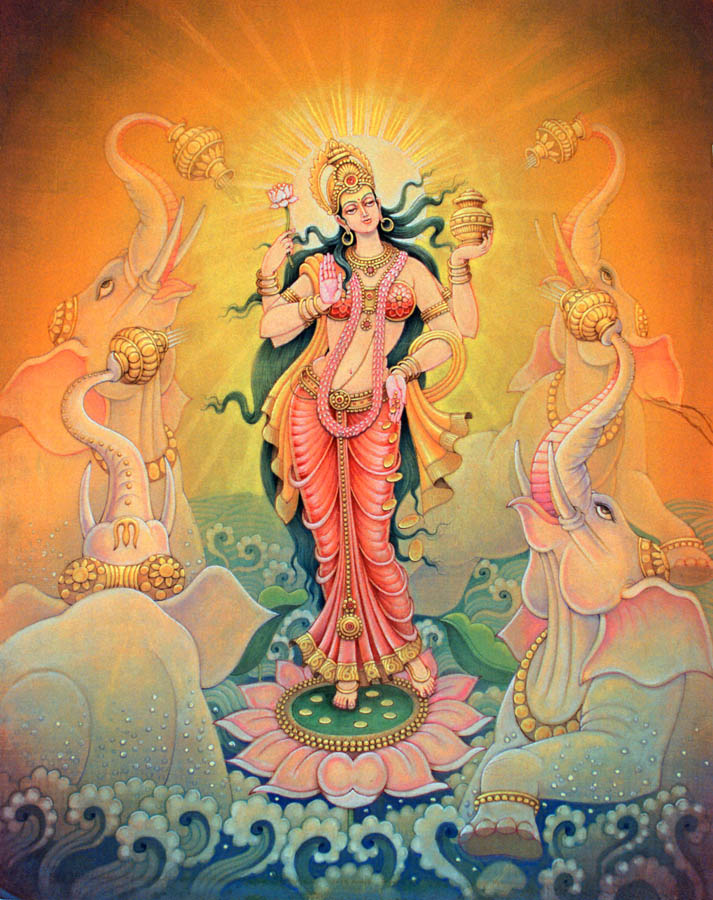
The red colour symbolises activity. The golden lining (embroidery) on her red dress denotes prosperity. The idea conveyed here is that the Goddess is always busy distributing wealth and prosperity to the devotees.
The lotus seat, which Laxmi is standing upon, signifies that while living in this world, one should enjoy its wealth, but not become obsessed with it. Such a living is analogous to a lotus that grows in water but is not wetted by water.
The four hands represent the four ends of human life: Dharma (righteousness), Kama (genuine desires), Artha (wealth), and Moksha (liberation from birth and death).
The front hands represent the activity in the physical world and the back hands indicate the spiritual activities that lead to spiritual perfection.
Since the right side of the body symbolises activity, a lotus in the back right hand conveys the idea that one must perform all duties in the world in accordance with dharma.
This leads to moksha (liberation), which is symbolised by a lotus in the back left hand of Laxmi.
The golden coins falling on the ground from the front left hand of Laxmi illustrate that She provides wealth and prosperity to Her devotees. Her front right hand is shown bestowing blessings upon the devotees.
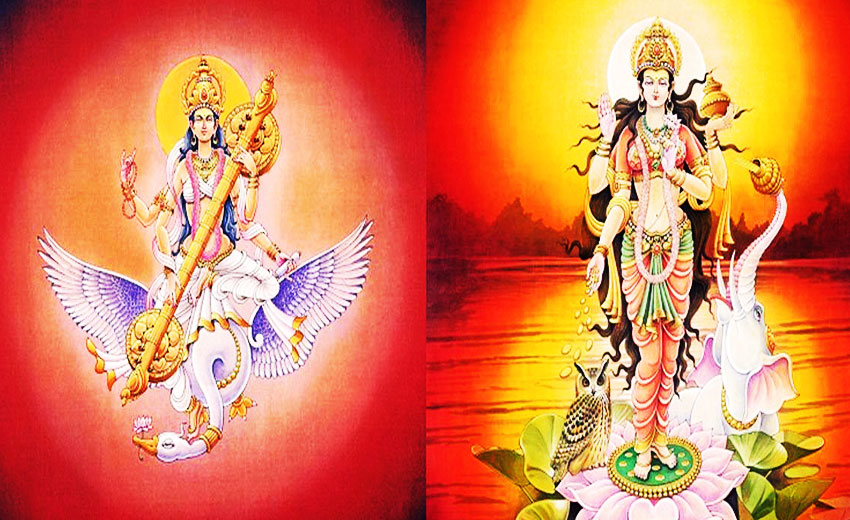
The two elephants standing next to the Goddess symbolise the name and fame associated with worldly wealth.
The idea conveyed here is that a true devotee should not earn wealth merely to acquire name and fame or only to satisfy his own material desires, but should share it with others in order to bring happiness to others in addition to himself.
According to the famous belief, the Goddess of knowledge Saraswati and the Goddess of wealth, Laxmi never had love between two of them. That is why a scholar is most of the time poor.
Briharthari has said that even though Laxmi is the Goddess of money, wealth and prosperity, she does not stay for long with people who are proud of their money. That is why Laxmi bestows upon her blessings only on those who are pious in the long run.
Laxmi’s carrier is an owl who cannot see in the daylight. According to the public belief, on the day of Deepavali, while worshipping the Goddess of wealth Laxmi, the main door of the house is left open and at the entrance of the main door, light is kept so that Laxmi’s carrier owl does not have a problem in coming inside.
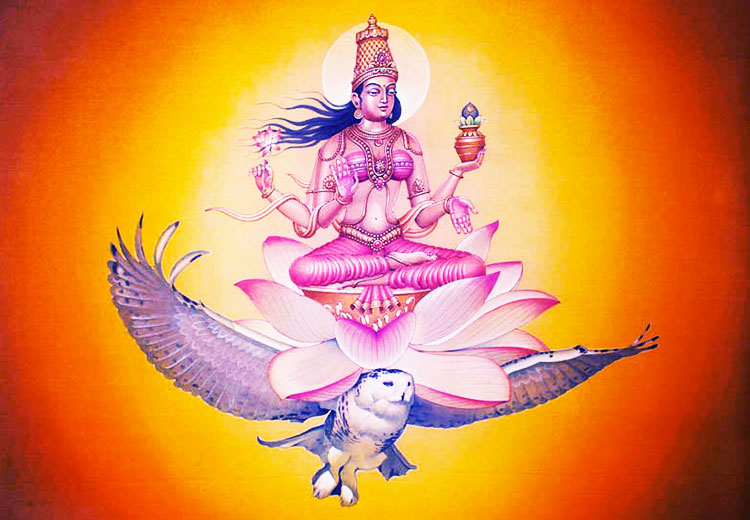
As for now, this is the famous belief of the public minds, but according to the ancient stories, out of the ten incarnation of Shri Vishnu, Krishna’s incarnation was one of them.
In the Dwapar age, during the time of Shri Krishna, Laxmi was incarnated as Radha. The word Laxmi’s mention is found in the Vedas also.
On the full moon night following Dusshera or Durga Puja, Hindus worship Laxmi ceremonially at home, pray for her blessings, and invite neighbors to attend the puja.
It is believed that on this full moon night the goddess herself visits the homes and replenishes the inhabitants with wealth. A special worship is also offered to Laxmi on the auspicious Diwali night.
Devis are very mysterious in Hindu culture and religion. Very few cultures have given so much of importance to female worship. The most important portfolios have been given to the female energies; their male counterparts are believed not to be as active in the world as the female counterparts.
Also concepts such as Durga (combination of Laxmi, Saraswati and Kali) and Adi-Mata (the original female goddess whom the entire universe took birth) highlight the importance of female worshipping in India.
 Pieter Weltevrede– is a Master “Sacred-Artist” based out of the Nederlands. After a many years of guidance, under his guru Late Harish Johari a successful author, a gifted painter and sculptor, a lifetime scholar, an inspiring teacher, a splendid cook, an ayurvedic massage miracle, etc., Pieter embarked on his own journey amalgamating ancient Indian knowledge with his own western sensibilities evolving an art form that appeals to todays international audience. He has been practising his art form from the last 40 years now.
Pieter Weltevrede– is a Master “Sacred-Artist” based out of the Nederlands. After a many years of guidance, under his guru Late Harish Johari a successful author, a gifted painter and sculptor, a lifetime scholar, an inspiring teacher, a splendid cook, an ayurvedic massage miracle, etc., Pieter embarked on his own journey amalgamating ancient Indian knowledge with his own western sensibilities evolving an art form that appeals to todays international audience. He has been practising his art form from the last 40 years now.
His original paintings are in water colours on silk with a wash-technique that gives them a very three-dimensional feel. The complexity and detail in his works are a super-human endeavour as he continues to live a mundane life travelling between the Western World and India.
Here, ‘Goddess Lakshmi’ paintings are printed on coated matt paper by inkjet printer, using ultra chrome inks with an off-white paper mounting with golden border, and encased inside a fibre frame with acrylic sheet cover in the front.
Click Here to visit our Shop Site.


